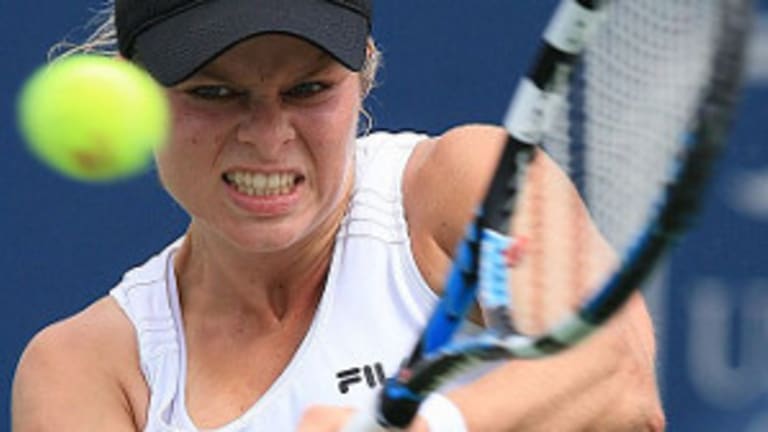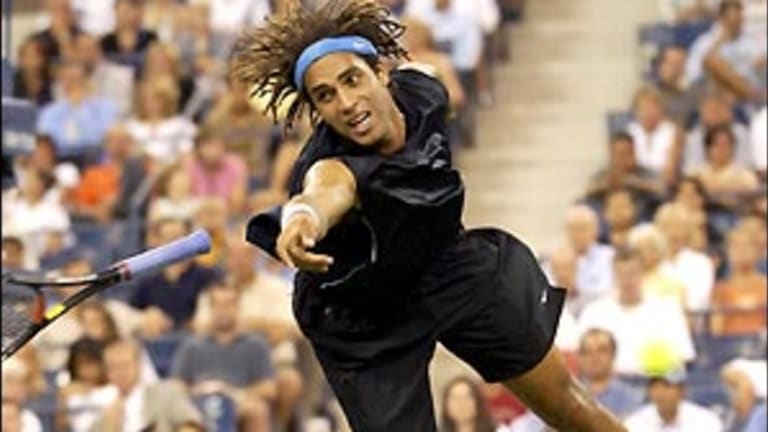The Rally: Back on the Bus
By Steve Tignor Jul 23, 2014No. 1 Read
Rafael Nadal cements lasting legacy with Roland Garros dominance
By Joel Drucker and Steve Tignor May 24, 2025Federer Turns 40
The Rally: 20-plus years in the making, how writing The Master humanized Federer for its author
By Steve Tignor Aug 08, 2021Roland Garros
The Rally: Is Novak Djokovic's Roland Garros triumph the most remarkable of his 19 Slam-title runs?
By Joel Drucker and Steve Tignor Jun 13, 2021The Rally: Sliding into the clay swing as Roland Garros looms
By Joel Drucker and Steve Tignor May 10, 2021The Rally: How notable is Novak Djokovic's new No. 1 ranking record?
Mar 09, 2021The Rally: A Wild Idea
By Steve Tignor Sep 03, 2015Role Model
By Steve Tignor Dec 19, 2014The Rally: Off-Season? What Off-Season?
By Steve Tignor Dec 18, 2014The Rally: Transition Time
By Steve Tignor Jun 11, 2014The Rally: Back on the Bus
Assessing the U.S. Open Series as it turns 10.
Published Jul 23, 2014
Advertising
Fellow TENNIS.com editor Richard Pagliaro and I discuss the U.S. Open Series, which turns 10 years old this week.
It’s been a decade since the USTA, and its go-getter U.S. Open tournament director at the time, Arlen Kantarian, created the U.S. Open Series. But doesn’t it feel like it’s been around for much longer? Maybe that’s a sign of how quickly time passes in tennis, and how quickly eras begin and end. It was just a few years ago when the now-retired Andy Roddick and Kim Clijsters were winning the series and collecting its bonus money, but it feels like a different time entirely. (Just look at the ad above, from 2006.)
Kantarian is long gone from the USTA, but the U.S. Open Series lives on. The idea was to link the US Open and its lead-up tournaments and create a summer tennis season in the States—the events have their own sponsors, standings, and bonus pool, and they’re broadcast at roughly the same time each week on ESPN and Tennis Channel. Kantarian, a tennis outsider when he started, was a big believer in the power of the majors—he wanted the ATP’s Masters Series to be called the “Grand Slam Series” instead. Ten years later, how does his vision look? Has the Open Series been a success, Richard? I'll start by saying that, unfortunately for the blue bus, it embarked on its cross-country journey just as the men's game was flying off to Switzerland, Spain, and Serbia.
Advertising
Arlen worked for both the NFL and Radio City, and I think his vision for the U.S. Open Series was shaped by both. It aimed to create mounting weekly interest, like the NFL playoffs, and peaking with its Super Bowl, while amping up the star power to sell the game's health benefits and pop-culture appeal.
The Open Series's successes have been streamlined TV coverage, increased prize money, and branding. I think its primary struggles are sustaining domestic tournaments (California has lost two traditional events) and enticing non-American stars to play with the bonus money.

The Rally: Back on the Bus
Advertising
When the series launched, domestic summer tournament coverage was cobbled together across several networks (CBS and USA Network still had U.S. Open rights then), so I like the fact that it gave summer tennis a permanent home (ESPN and Tennis Channel) at a predictable time each weekend. I remember Clijsters making history when she won the U.S. Open Series and later the U.S. Open, becoming the first female athlete to cash a $1 million prize check. This year, each U.S. Open singles champion will collect a $3 million check. Bundling the summer tournaments together also gives the game more marketing muscle.
But many of the top players prefer to take a mid-season break before returning for Rogers Cup and Cincinnati, rather than chase bonus money. Do you think that will change, and despite the fact Cincinnati has grown, what will the loss of San Diego and L.A. mean long-term?
In a way, the U.S. Open Series shows that tennis is an individual sport even when it comes to tournaments—they live and die on their own. Over the last 10 years, the summer events in the States have had wildly different fates: As you mentioned, long-running tournaments in Indianapolis, L.A., and San Diego are gone; Atlanta and Winston-Salem, even though they're in tennis-centric areas, have struggled; yet D.C., which nabbed a new title sponsor, and Cincinnati, which is now dual-gender, have thrived.
The Open Series also shows that the top players are beyond worrying about prize money. Kantarian thought that offering cash to the winner would create excitement and draw the best players from Europe. But the bonus pool has always seemed like overkill, and Djokovic, Nadal, Federer, and Murray have never been drawn by the prospect of winning it. What gets them over here are the mandatory ATP events in Canada and Cincy. In that sense, I think Kantarian underestimated the eventual power of the Masters Series. The ATP has had more success branding those events and getting the players to commit to them than he thought it would. On the other hand, sponsors like Mercedes Benz have continued to migrate away from the tours and toward the US Open itself. New York, rather than the road that leads to it, is still the place to be as far as they're concerned.
As for the mid-season slowdown after Wimbledon, I think it's good for fans and players to get a break.
What else do you think can be done to help the early events in the Open Series, Richard? Anything?
Advertising

The Rally: Back on the Bus
Tennis is a star-driven sport, and the stars aren't going to play those smaller events because peaking for the Open is the priority. It's exciting to see younger players emerge—I remember seeing a young James Blake beat Andre Agassi in the 2002 D.C. semis, for instance—but with U.S. men's tennis lacking depth, those runs become rare.
Some creative tournament directors have tried incorporating other activities into the tournament schedule to draw fans. I remember years ago when John Korff ran a pre-U.S. Open exhibition in Mahwah, N.J., he hosted concerts during the tournament (and have the players on stage with the bands), a beer garden, wine-tasting, chili cook-offs, beach tennis exos, and local sponsor booths with giveaways. From an attendance perspective, it helped because it gave casual fans added value and potentially appealed to a wider audience.
Cincinnati and Charleston (in the spring) have succeeded in making their tournaments community events, but both have title sponsors. A challenge for smaller summer tournaments is, how do you get fans to watch tennis during the busiest season to play tennis? If more courts were available, it would be cool to see some of the smaller events host USTA tournaments simultaneously—the U.S. Open once hosted the National Family Championships during the second week of Flushing Meadows. Newport is a real jewel of American tennis, but because of its surface and spot in the schedule, it hasn't fit in the Series. How do you see the U.S. Open Series evolving in the next five years, Steve?
Advertising
That's a good question. To me, the U.S. Open Series and World Team Tennis were both honorable attempts to transplant ideas from other sports (the team concept, the playoff concept) to tennis, but in both cases the time and effort and money available hasn't been sufficient to change the way this sport operates.
If we want to see what has worked, we need to look at D.C., Canada, Cincy, and, on a smaller scale, Stanford. Each tournament has been around, mostly in one place, for a long time. Each has an audience that is going to show up no matter what. D.C., Stanford, Toronto, and Montreal serve highly populated areas, while Cincy is the biggest tournament in the heartland—people who can't make the U.S. Open will travel there to see Rog, Rafa, Serena, and company. D.C. has a solid title sponsor in Citigroup, which has allowed the tournament to start paying appearance fees again, something it had stopped doing five or six years ago. Cincy also has a title sponsor, but it benefits especially from being owned by the USTA. All of them benefit from being played late enough in the summer that the biggest names from Europe are ready to begin their summer U.S. campaigns.
And that's the problem for any other events—the calendar is full, and the prime early August weeks are already being maximized. The one thing I always wonder at this time of year is whether the Chicago area couldn't put together a summer event. If there's one metropolitan area that's crying out for tennis, it's that one. Oh, and maybe it's time to bring back the bus trip ads, no?
Any ideas from your side, Richard?
Sometimes, the tennis calendar is a crowded house; it's tough to redesign a room that's already overstuffed. The crammed schedule means revisions are more realistic to realize than grand visions. Here are a few things I'd like to see for U.S. Open Series:
*More combined events. Obviously cost, facilities, and sponsorship are issues (and questions of how beneficial it is for the ATP), but the most successful American tournaments are combined events. Tennis has that advantage over almost all other sports, but doesn't always realize it.
*Free qualies and practice sessions. The U.S. Open qualies have grown over the years, and I run into some of the same people who return when the Open itself begins. Open the door, invite new and lapsed fans to see the game up close, and some will be impressed enough to come back to these tournaments.
*Expand alliance between community tennis and pro events. The opportunity to win a wild card into the U.S. Open qualies makes the U.S. Open National Playoffs my favorite tennis promotional event. I'd like to see more tournaments do it (Delray Beach has done it for a while), and more tournaments should host sectional, junior, and senior events either right before or right after these pro tournaments.
*Return of tournaments to Chicago and L.A. They are both major tennis cities and have successfully hosted tournaments in the past. While some point to the fact L.A. doesn't even have an NFL franchise anymore as a sign of fan apathy, it's such a strong tennis community they deserve another shot. The USTA once billed the U.S. Open Series as "The Greatest Road Trip in Sports." They could make it a moveable feast and alternate an event between the two cities, as Rogers Cup does with Montreal and Toronto.